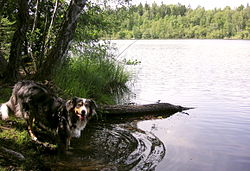Judarn
| Judarn | |
|---|---|

Lake Judarn in the nature reserve Judarskogen, in summer 2008
|
|
| Location | Bromma, |
| Coordinates | 59°20′13.96″N 17°54′51.14″E / 59.3372111°N 17.9142056°ECoordinates: 59°20′13.96″N 17°54′51.14″E / 59.3372111°N 17.9142056°E |
| Primary inflows | Local stormwater |
| Primary outflows | Mälaren |
| Catchment area | 0.8 km2 (0.31 sq mi) |
| Basin countries | Sweden |
| Surface area | 74,000 m2 (800,000 sq ft) |
| Average depth | 2.7 m (8 ft 10 in) |
| Max. depth | 3.7 m (12 ft) |
| Water volume | 179,000 m3 (145 acre·ft) |
| Residence time | 11 months |
| Settlements | |
Judarn is the name of a small lake in Bromma, a western suburb in , Sweden. Surrounded by the forest and nature reserve Judarskogen, it stretches between Åkeshov and Södra Ängby. Three other lakes are found nearby: Kyrksjön, Lillsjön, and Råcksta Träsk. The name is etymologically associated to ljuda, the verb "to sound".
With an area of 74,000 square metres and an average depth of 2.7 metres (maximum 3.7 m), the lake contains 180,000 cubic metres of water and is supplied by a drainage area of 0.8 km². Originally supplying lake Lillsjön, Judarn today discharges into lake Mälaren. Regarded as one of the least contaminated lakes in Stockholm, Judarn receives storm water from a nearby traffic route which gives it considerable levels of lead resulting in a bathing ban, metal content otherwise being low and phosphorus levels moderate. The lake, considered as being of great recreational and natural value, is part of the nature reserve Judarskogen and has a rich flora and fauna with many aquatic plants, birds, and frogs. Its isolated location combined with low levels of chlorophyll makes Judarn one of the clearest lakes in Stockholm, and notwithstanding low levels of oxygen nutrient content is low even during winters, with raised levels of PAH and PCB in deep sediments.
Geological traces of the inland ice which withdrew from the area some 11,000 years ago are found in the moraines around the lake. The huge square blocks of stone scattered in the area are the result of the earthquakes produced by the tension caused by the retiring ice. The geologist Gerhard de Geer studied the surrounding moraine ridges, which were eventually given his name, and geological excursions are still common in the area.
...
Wikipedia
